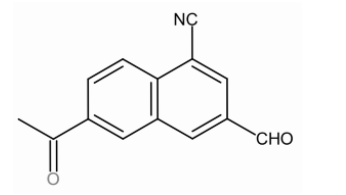
Double bond equivalent of the following is:

A. 7
B. 11
C. 6
D. None of these

Answer
589.8k+ views
Hint: The double bond equivalent or level of unsaturation is the number of unsaturation present in an organic molecule. We can find this by the formula:
\[DBE=C+\dfrac{H}{2}-\dfrac{X}{2}+\dfrac{N}{2}\]
Complete step by step solution:
The term unsaturation here means a double bond or a ring system. For example, in benzene there are 3 double bonds and 1 ring which gives us 4 DBE.
Moreover, a triple bond can be regarded as DBE=2.
It must be noted that in the formula
\[DBE=C+\dfrac{H}{2}-\dfrac{X}{2}+\dfrac{N}{2}\]
Presence of an oxygen atom does not affect the DBE calculation.
Now, in this compound the number of Carbon atoms are 14.
Therefore, from the above solution we can conclude that the correct answer is (b).
Note: Remember, the degrees of unsaturation only give the sum of double bonds, triple bonds and/or rings. For instance, a degree of unsaturation of 3 can contain 3 rings, 2 rings and one double bond, 1 ring and two double bonds, 1 ring and triple bond, 1 double bond and one triple bond, or 3 double bonds.
\[DBE=C+\dfrac{H}{2}-\dfrac{X}{2}+\dfrac{N}{2}\]
Complete step by step solution:
The term unsaturation here means a double bond or a ring system. For example, in benzene there are 3 double bonds and 1 ring which gives us 4 DBE.
Moreover, a triple bond can be regarded as DBE=2.
It must be noted that in the formula
\[DBE=C+\dfrac{H}{2}-\dfrac{X}{2}+\dfrac{N}{2}\]
where, X is the total number of halogens, namely Cl, Br, F and I present in the structure.
C = number of carbon atoms.
H = number of Hydrogen atoms.
N = number of nitrogen atoms.
Presence of an oxygen atom does not affect the DBE calculation.
Now, in this compound the number of Carbon atoms are 14.
Number of Hydrogen atoms is 9.
Number of Nitrogen atoms is 1.
Number of halogen atoms is 0
On applying the DBE formula:
\[=14+1-\dfrac{9}{2}+\dfrac{1}{2}\]
= 15 - 4
= 11
Therefore, from the above solution we can conclude that the correct answer is (b).
Note: Remember, the degrees of unsaturation only give the sum of double bonds, triple bonds and/or rings. For instance, a degree of unsaturation of 3 can contain 3 rings, 2 rings and one double bond, 1 ring and two double bonds, 1 ring and triple bond, 1 double bond and one triple bond, or 3 double bonds.
Recently Updated Pages
A man running at a speed 5 ms is viewed in the side class 12 physics CBSE

State and explain Hardy Weinbergs Principle class 12 biology CBSE

Which of the following statements is wrong a Amnion class 12 biology CBSE

Two Planoconcave lenses 1 and 2 of glass of refractive class 12 physics CBSE

The compound 2 methyl 2 butene on reaction with NaIO4 class 12 chemistry CBSE

Bacterial cell wall is made up of A Cellulose B Hemicellulose class 12 biology CBSE

Trending doubts
What are the major means of transport Explain each class 12 social science CBSE

Which are the Top 10 Largest Countries of the World?

Draw a labelled sketch of the human eye class 12 physics CBSE

Explain sex determination in humans with line diag class 12 biology CBSE

Give 10 examples of unisexual and bisexual flowers

State the principle of an ac generator and explain class 12 physics CBSE




